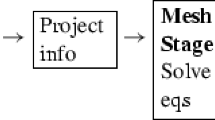Abstract
This paper proposes a coupled particle–finite element method for fluid–membrane structure interaction problems. The material point method (MPM) is employed to model the fluid flow and the membrane element is used to model the membrane structure. The interaction between the fluid and the membrane structure is handled by a contact method, which is implemented on an Eulerian background grid. Several numerical examples, including membrane sphere interaction, water sphere impact and gas expansion problems, are studied to validate the proposed method. The numerical results show that the proposed method offers advantages of both MPM and finite element method, and it can be used to simulate fluid–membrane interaction problems.


















Similar content being viewed by others
References
Antoci, C., Gallati, M., Sibilla, S.: Numerical simulation of fluid–structure interaction by SPH. Comput. Struct. 85, 879–890 (2007)
Bardenhagen, S.G., Brackbill, J.U., Sulsky, D.: The material-point method for granular materials. Comput. Methods Appl. Mech. Eng. 187(3–4), 529–541 (2000)
Daneshmand, F., Niroomandi, S.: Natural neighbour Galerkin computation of the vibration modes of fluid–structure systems. Eng. Comput. 24(3–4), 269–287 (2007)
Flanagan, D.P., Belytschko, T.: A uniform strain hexahedron and quadrilateral with orthogonal hourglass control. Int. J. Numer. Methods Eng. 17, 679–706 (1981)
Gan, Y., Chen, Z., Montgomery-Smith, S.: Improved material point method for simulating the zona failure response in piezo-assisted intracytoplasmic sperm injection. Comput. Model. Eng. Sci. 73(1), 45–76 (2011)
Gonzalez, D., Cueto, E., Chinesta, F. et al.: A natural element updated Lagrangian strategy for free-surface fluid dynamics. J. Comput. Phys. 223, 127–150 (2007)
Hallquist, J.O.: LS-DYNA Theoretical Manual. Livermore Software Technology Corporation, Livermore (1998)
Hu, W., Chen, Z.: A multi-mesh MPM for simulating the meshing process of spur gears. Comput. Struct. 81, 1991–2002 (2003)
Huang, P., Zhang, X., Ma, S., Huang, X.: Contact algorithms for the material point method in impact and penetration simulation. Int. J. Numer. Methods Eng. 85(4), 498–517 (2011)
Hughes, T.J.R., Liu, W.K., Zimmermann, T.K.: Lagrangian–Eulerian finite element formulation for incompressible viscous flows. Comput. Methods Appl. Mech. Eng. 29(3), 329–349 (1981)
Idelsohn, S.R., Onate, E., Del Pin, F.: The particle finite element method: a powerful tool to solve incompressible flows with free-surfaces and breaking waves. Int. J. Numer. Methods Eng. 61(7), 964–989 (2004)
Idelsohn, S.R., Marti, J., Limache, A., Onate, E.: Unified Lagrangian formulation for elastic solids and incompressible fluids: application to fluid–structure interaction problems via the PFEM. Comput. Methods Appl. Mech. Eng. 197(19–20), 1762–1776 (2008)
Lee, C.J.K., Noguchi, H., Koshizuka, S.: Fluid–shell structure interaction analysis by coupled particle and finite element method. Comput. Struct. 85, 688–697 (2007)
Lian, Y.P., Zhang, X., Liu, Y.: Coupling of finite element method with material point method by local multi-mesh contact method. Comput. Methods Appl. Mech. Eng. 200, 3482–3494 (2011)
Liu, M.B., Liu, G.R.: Smoothed particle hydrodynamics (SPH): an overview and recent developments. Arch. Comput. Methods. Eng. 17, 25–76 (2010)
Luo, H.X., Mittal, R., Zheng, X.D., Bielamowicz, S.A., Walsh, R.J., Hahn, J.K.: An immersed-boundary method for flow–structure interaction in biological systems with application to phonation. J. Comput. Phys. 227(22), 9303–9332 (2008)
Ma, Z., Zhang, X., Huang, P.: An object-oriented MPM framework for simulation of large deformation and contact of numerous grains. Comput. Model. Eng. Sci. 55(1), 61–87 (2010)
Rafiee, A., Thiagarajan, K.P.: An SPH projection method for simulating fluid–hypoelastic structure interaction. Comput. Methods Appl. Mech. Eng. 198(33–36), 2785–2795 (2009)
Souli, M., Ouahsine, A., Lewin, L.: ALE formulation for fluid–structure interaction problems. Comput. Methods Appl. Mech. Eng. 190(5–7), 659–675 (2000)
Sulsky, D., Chen, Z., Schreyer, H.L.: A particle method for history-dependent materials. Comput. Methods Appl. Mech. Eng. 118(1–2), 179–196 (1994)
Walhorn, E., Kölke, A., Hübner, B., Dinkler, D.: Fluid–structure coupling within a monolithic model involving free surface flows. Comput. Struct. 83, 2100–2111 (2005)
York, A.R. II, Sulsky, D., Schreyer, H.L.: Fluid–membrane interaction based on the material point method. Int. J. Numer. Methods Eng. 48, 901–924 (2000)
Acknowledgments
The research described in this paper was financially Supported by the China Postdoctoral Science Foundation (2013M530040), National Basic Research Program of China (2010CB832701), National Natural Science Foundation of China (11272180), and Tsinghua University Initiative Scientific Research Program.
Author information
Authors and Affiliations
Corresponding author
Rights and permissions
About this article
Cite this article
Lian, YP., Liu, Y. & Zhang, X. Coupling of membrane element with material point method for fluid–membrane interaction problems. Int J Mech Mater Des 10, 199–211 (2014). https://doi.org/10.1007/s10999-014-9241-6
Received:
Accepted:
Published:
Issue Date:
DOI: https://doi.org/10.1007/s10999-014-9241-6




